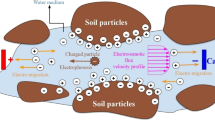Abstract
Throughout the world, subsurface contamination has become a widespread and pervasive problem. Toxic chemicals such as heavy metals and organic compounds are commonly used in a myriad of industries. However, largely through inadvertent or accidental release, these chemicals are presently polluting sites across the United States. In order to protect public health and the environment, further pollution must be prevented and sites with existing contamination urgently need remediation. Unfortunately, remediating subsurface contamination has proved to be a daunting task. Heavy metals and organic compounds often coexist and their distribution within the subsurface is highly dependent on particle and macro-scale heterogeneities. Vast resources have been invested to develop efficient remediation technologies, yet very few of these technologies have been successful. In-situ remediation is often preferred due to minimal site disturbance, safety, simplicity, and cost-effectiveness. The effectiveness of in-situ remediation technologies depends largely on the contaminant chemistry and subsurface heterogeneities (including particle-scale heterogeneities such as fine-grained soils, soils with reactive minerals, and/or soils rich in organic matter as well as macro-scale heterogeneities such as irregular soil layers and/or lenses). Under such heterogeneous conditions, integrated electrokinetic remediation technology has great potential. As a safe and economical remedial option for so many contaminated sites, the application of integrated electrokinetic remediation offers enormous public health, environmental, and financial benefits.







Similar content being viewed by others
References
Acar YB, Gale RJ, Alshawabkeh AN, Marks RE, Puppala S, Bricka M et al (1995) Electrokinetic remediation: basics and technology status. J Hazard Mater 40(2):117–137. doi:10.1016/0304-3894(94)00066-P
Al-Hamdan AZ, Reddy KR (2005) Surface speciation modeling of heavy metals in kaolin: implications for electrokinetic soil remediation processes. Adsorpt J 11(5–6):529–546. doi:10.1007/s10450-005-5611-6
Alshawabkeh AN, Yeung AT, Bricka MR (1999) Practical aspects of in-situ electrokinetic extraction. J Environ Eng 125(1):27–35. doi:10.1061/(ASCE)0733-9372(1999)125:1(27)
Amrate S, Akretche DE, Innocent C, Seta P (2005) Removal of Pb from a calcareous soil during EDTA-enhanced electrokinetic extraction. Sci Total Environ 349(1–3):56–66. doi:10.1016/j.scitotenv.2005.01.018
Deng X, Jennings AA (2006) Evaluating an electrokinetically driven extraction method for measuring Heavy metal soil contamination. J Environ Eng 132(4):527–537. doi:10.1061/(ASCE)0733-9372(2006)132:4(527)
Isosaari P, Piskonen R, Ojala P, Voipio S, Eilola K, Lehmus E, Itävaara M (2007) Integration of electrokinetics and chemical oxidation for the remediation of creosote-contaminated clay. J Hazard Mater 144(1–2):538–548. doi:10.1016/j.jhazmat.2006.10.068
Khodadoust AP, Reddy KR, Narla O (2006) Cyclodextrin-enhanced electrokinetic remediation of soils contaminated with 2,4-dinitrotoluene. J Environ Eng 132(9):1043–1050. doi:10.1061/(ASCE)0733-9372(2006)132:9(1043)
Li A, Cheung KA, Reddy KR (2000) Cosolvent enhanced electrokinetic remediation of soils contaminated with phenanthrene. J Environ Eng 126(6):527–533. doi:10.1061/(ASCE)0733-9372(2000)126:6(527)
Maturi K, Reddy KR (2006) Simultaneous removal of heavy metals and organic contaminants from soils by electrokinetics using a modified cyclodextrin. Chemosphere 63(6):1022–1031. doi:10.1016/j.chemosphere.2005.08.037
Niqui-Arroyo J-L, Ortega-Calvo J-J (2007) Integrating biodegradation and electroosmosis for the enhanced removal of polycyclic aromatic hydrocarbons from creosote-polluted soils. J Environ Qual 36(5):1444–1451. doi:10.2134/jeq2006.0516
Page MM, Page CL (2002) Electroremediation of contaminated soils. J Environ Eng 128(3):208–219. doi:10.1061/(ASCE)0733-9372(2002)128:3(208)
Reddy KR, Chinthamreddy S (2003) Sequentially enhanced electrokinetic remediation of heavy metals in low buffering clayey soils. J Geotech Geoenviron Eng 129(3):263–277. doi:10.1061/(ASCE)1090-0241(2003)129:3(263)
Reddy KR, Chinthamreddy S (2004) Enhanced electrokinetic remediation of heavy metals in glacial till soils using different electrolyte solutions. J Environ Eng 130(4):442–455. doi:10.1061/(ASCE)0733-9372(2004)130:4(442)
Reddy KR, Karri MR (2006) Effect of voltage gradient on integrated electrochemical remediation of contaminant mixtures. Land Contam Reclam 14(3):685–698. doi:10.2462/09670513.786
Reddy KR, Maturi K (2005) Enhanced electrokinetic remediation of mixed heavy metal and organic contaminants in low permeability soils. In: Proceedings of the 16th international conference on soil mechanics and geotechnical engineering. Millpress Science Publishers, Rotterdam, Netherlands, pp 2429–2432
Reddy KR, Parupudi US (1997) Removal of chromium, nickel and cadmium from clays by in-situ electrokinetic remediation. J Soil Contam 6(4):391–407
Reddy KR, Saichek RE (2003) Effect of soil type on the electrokinetic removal of phenanthrene using surfactants and cosolvents. J Environ Eng 129(4):336–346. doi:10.1061/(ASCE)0733-9372(2003)129:4(336)
Reddy KR, Saichek RE (2004) Enhanced electrokinetic removal of phenanthrene from clay soil by periodic electric potential application. J Environ Sci Health A Tox Hazard Subst Environ Eng A 39(5):1189–1212
Reddy KR, Parupudi US, Devulapalli SN, Xu CY (1997) Effects of soil composition on removal of chromium by electrokinetics. J Hazard Mater 55(1–3):135–158. doi:10.1016/S0304-3894(97)00020-4
Reddy KR, Xu CY, Chinthamreddy S (2001) Assessment of electrokinetic removal of heavy metals from soils by sequential extraction analysis. J Hazard Mater 84(2–3):85–109. doi:10.1016/S0304-3894(01)00237-0
Reddy KR, Chaparro C, Saichek RE (2003a) Removal of mercury from clayey soils using electrokinetics. J Environ Sci Health A Tox Hazard Subst Environ Eng A38(2):307–338
Reddy KR, Chaparro C, Saichek RE (2003b) Iodide-enhanced electrokinetic remediation of mercury-contaminated soils. J Environ Eng 129(12):1137–1148. doi:10.1061/(ASCE)0733-9372(2003)129:12(1137)
Reddy KR, Danda S, Saichek RE (2004) Complicated factors of using ethylenediamine tetracetic acid to enhance electrokinetic remediation of multiple heavy metals in clayey soils. J Environ Eng 130(11):1357–1366. doi:10.1061/(ASCE)0733-9372(2004)130:11(1357)
Ribeiro AB, Rodriguez-Maroto JM, Mateus EP, Gomes H (2005) Removal of organic contaminants from soils by an electrokinetic process: the case of atrazine. Experimental and modeling. Chemosphere 59(9):1229–1239. doi:10.1016/j.chemosphere.2004.11.054
Saichek RE, Reddy KR (2003) Effect of pH control at the anode on the electrokinetic removal of phenanthrene from kaolin soil. Chemosphere 51:273–287. doi:10.1016/S0045-6535(02)00849-4
Saichek RE, Reddy KR (2005) Surfactant-enhanced electrokinetic remediation of polycyclic aromatic hydrocarbons in heterogeneous subsurface environments. J Environ Eng Sci 4(5):327–339. doi:10.1139/s04-064
Sawada A, Mori K-I, Tanaka S, Fukushima M, Tatsumi K (2004) Removal of Cr(VI) from contaminated soil by electrokinetic remediation. Waste Manag 24(5):483–490. doi:10.1016/S0956-053X(03)00133-8
Sharma HD, Reddy KR (2004) Geoenvironmental engineering: site remediation, waste containment, and emerging waste management technologies. Wiley, Hoboken, NJ
United States Environmental Protection Agency (USEPA) (1997) Cleaning up the nation’s waste sites: markets and technology trends, EPA 542-R-96-005. Office of Solid Waste and Emergency Response, Washington, DC
USEPA (2000) Innovative remediation technologies: field-scale demonstration projects in North America, 2nd edn, EPA 542-B-00-004, USEPA, Washington, DC
USEPA (2006) Abstracts of remediation case studies, vol 10, EPA 542-R-06-002. USEPA, Washington, DC
Author information
Authors and Affiliations
Corresponding author
Rights and permissions
About this article
Cite this article
Reddy, K.R. Technical Challenges to In-situ Remediation of Polluted Sites. Geotech Geol Eng 28, 211–221 (2010). https://doi.org/10.1007/s10706-008-9235-y
Received:
Accepted:
Published:
Issue Date:
DOI: https://doi.org/10.1007/s10706-008-9235-y




